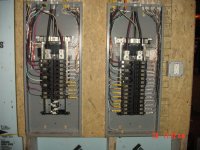Stevenfyeager
Senior Member
- Location
- United States, Indiana
- Occupation
- electrical contractor
I've seen houses with two panels, one dedicated to two pole breaker circuits and the other panel for 120 v circuits. And some of you have posted you like doing that. What are the advantages ? I will have two 200 amp panels. (actually, here it is a total 320 amps but called '400 amps' service ) Thank you.



